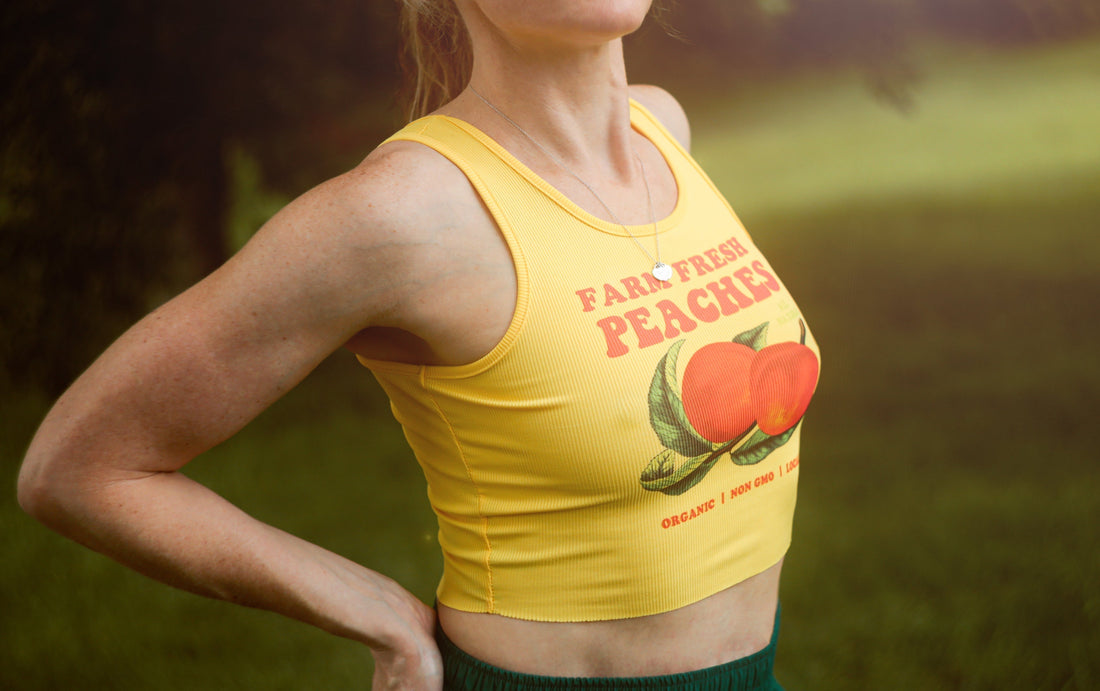
The Ultimate Guide to Wearing a Bra or Going Braless
Well, this is awkward because we sell bras. But since this is a real topic and one that's usually taken up by everyone except bra-sellers, we think you deserve a fresh perspective. The decision to wear a bra or go braless is deeply personal, yet it’s often influenced by outside-yourself societal expectations and cultural norms. And obviously, there's going braless and then there's going braless. We think you deserve the freedom to decide to always wear a bra, sometimes, or even never at all. Our feelings won't be hurt, we promise.
Common Myths to Dispel
Before going any further, there's a long (very long) list of myths about "going braless" that have to be named and squashed. Here's a short sample:
- Going braless means you're trying to attract (sexual) attention. Nope.
- Going braless is only for women with small boobs. Nope.
- Going braless means your nipples will always show through. Nope.
- Going braless is only for younger/older women. Nope.
- Going braless is because you forgot to do laundry. Ok, maybe.
The important bit to understand is that the choice to do life not wearing a bra is your choice. Yours. For your reasons. For your boobs. For your body. For yourself. You.
Understanding the Social Pressure to Wear a Bra
Society has long placed expectations on women’s bodies, particularly when it comes to breasts and nipples. At one time it was ankles, arms or legs; now it's hyper-focused on all things boobs. Bras have long been marketed as essential and central garments for modesty, support, and shaping, with the unspoken rule that visible nipples or natural breast shapes are inappropriate in public, even if not directly visible. It makes sense in that cultural context just how there came to be such a strong stigma around going braless.
-
Cultural Norms: Bras are seen as a standard part of women’s attire, especially in professional or formal settings. The expectation to wear a bra is often tied to ideas of “propriety” or “professionalism,” with noticeable nipples considered inappropriate: somewhere on the spectrum from distracting to outright sexual.
-
Media Influence: Media and fashion industries have perpetuated the idea that breasts should be lifted, shaped, or concealed to align with idealized body standards. This messaging can create pressure to conform, even when bras are uncomfortable, unnecessary or unwanted.
-
Double Standards: The scrutiny over women’s nipples highlights a gender disparity. Men’s nipples are rarely considered inappropriate, while women’s are heavily policed, revealing a deeper societal sensitivity with female bodies in their natural state.
These pressures can make the decision to go braless feel like an act of rebellion, even though it’s a natural and valid choice. Maybe that rebellion is a good thing for you; a middle finger to society is often very healthy and liberating!
The Case for Wearing a Bra
For many, bras offer physical, emotional, and social benefits. It's certainly not wrong to wear one, and it's beneficial to really take stock of your own reasons you wear bras. Here's a broad list, but if you have more specific reasons not listed here, embrace those.
-
Physical Support: Bras can provide support, particularly for those with larger or particularly pendulous/saggy breasts, reducing discomfort during physical activity or long days. Sports bras, for example, are designed to minimize movement and strain during exercise. Our boobs hurt when they move too much!
-
Shaping and Aesthetics: Some women prefer the look of a bra for shaping or enhancing their silhouette under clothing. Bras can also help achieve that "polished" appearance in professional or formal settings. Plus, it's nice feeling like you have some measure of control over how your body looks. Boobs are shape-able, and maximizing on that can be super confidence-boosting.
-
Social Comfort: Wearing a bra can help some women feel more confident in environments where they’re concerned about judgment or unwanted attention. We all have those places, even if we'd rather we didn't. For those navigating conservative workplaces or communities, a bra may feel like a shield against scrutiny. A "choose your battles" sort of choice.
-
Special Considerations: Certain medical conditions, like mastalgia (breast pain) may be alleviated by wearing a well-fitted bra. When breastfeeding, bras are great for supporting our suddenly larger, heavier and more sensitive boobs, and controlling inevitable leaks.
The Case for Going Braless
The braless movement has gained (and lost) momentum over the years, driven by a desire for comfort, body positivity, and challenging societal norms. The downside to all those outspoken movements is any decision to go braless can attach those ideals and movements to you without you actually being connected with them, which can further discourage any feeling of freedom to go without. But at its simplest, the broad landscape of going braless is roughly motivated by:
-
Comfort and Freedom: Bras can be restrictive. There's a reason corsets fell out of favor, and bras aren't a total solution to restriction. Going braless allows your body to move naturally, which many find not only liberating, but genuinely comfortable.
-
Body Positivity: Choosing to go braless can be an act of self-acceptance, embracing your body as it is without conforming to societal ideals. It challenges the notion that women’s bodies need to be altered or hidden. Your boobs don't have to be controlled!
-
Health Considerations: Some studies suggest that bras, especially ill-fitting ones, may contribute to discomfort or even health issues like skin irritation or restricted circulation. While more reliable research is needed, going braless may be healthier for some.
-
Cultural Shifts: The rise of inclusive fashion and the body positivity movement has normalized going braless in casual settings. Celebrities and influencers openly embracing the braless look have helped destigmatize (though not always de-sexualize) it.
Navigating the Nipple Stigma
One of the biggest barriers to going braless is the societal taboo around noticeable nipples. This stigma is rooted in the sexualization of women’s bodies, where nipples are deemed “provocative” or “unprofessional.” However, this perspective is increasingly being challenged:
-
Reframing the Narrative: Nipples are a natural part of the human body, and their visibility doesn’t inherently carry sexual intent (duh!). Movements like “Free the Nipple” advocate for gender equality and the right to choose how to present your body.
-
Practical Solutions: If you’re hesitant about noticeable/visible nipples but want to go braless, options like nipple covers, pasties, or layered clothing can offer a middle ground. These allow you to embrace comfort while navigating social settings.
-
Context Matters: Consider the environment when deciding to go braless. Casual settings like parks or social gatherings may feel more accepting, while workplaces or formal events might require more strategic choices, like lightweight bralettes, camisoles or looser clothing options.
Making Your Decision: Factors to Consider
Choosing whether to wear a bra or go braless is a deeply personal decision. Here are some factors to weigh, but be sure to consider your specific priorities and pressures:
-
Comfort: Prioritize what feels good for your body. If bras cause pain or irritation, explore braless options or try softer alternatives like bralettes or nipple covers.
-
Lifestyle: Consider your daily activities. If you’re active, a sports bra might be practical for support. For low-key days, going braless might be the ticket for ultimate comfort.
-
Social Setting: Reflect on the environments you’re in. Are you in a conservative workplace where a bra feels necessary, or a casual setting where going braless is accepted? Again, this is a "choose your battles" scenario. Is it more comfortable to "go along to get along" or are you driven to choose for yourself regardless of the consequences?
-
Personal Confidence: Your comfort with your body and its natural state plays a big role. If going braless feels empowering, it might be worth trying, even if it’s just at home initially. You're worth having that feeling and experience of power and agency over your body and life.
-
Body Type: Breast size and shape can influence your choice. Larger breasts may require more support for comfort, but many women with all body types find going braless freeing. Try to resist the urge to make assumptions and fall into myth traps.
Tips for Going Braless Confidently
If you’re considering going braless but feel hesitant, here are some tips to ease into it:
-
Start Easy: Try going braless at home or in low-stakes settings, like running errands, to build confidence. You may realize that everyone is truly in their own world and the fear of braless putting you (and your boobs) center stage with a giant spotlight...just isn't true.
-
Choose Strategic Clothing: Loose tops, thick fabrics, or layered outfits can minimize visibility while you adjust to the braless look. Certain patterns can camouflage otherwise very noticeable nipples poking through: floral, paisley, colorful prints and geometric/colorblock patterns can hide even the most extroverted nips!
-
Explore Alternatives: Bralettes, camisoles, or bandeau tops offer a compromise between support and freedom. Ditching highly structured bras for lighter support is still super freeing.
-
Practice Self-Compassion: Remind yourself that your body is yours to present as you choose. There’s no “right” or “wrong” decision—only what feels right for you. And we will gladly back you up on that.
-
Connect with Community: Online forums or social media groups focused on body positivity can provide support and inspiration from others who’ve gone braless. Make sure to read well around those first though as many are more focused on the fetishization aspect rather than freedom. sigh
Addressing Judgment and Criticism
Unfortunately, going braless can attract judgment and/or unwanted attention in some circles. If you face criticism, consider these approaches:
-
Set Boundaries: Politely but firmly assert your right to make choices about your body. A simple, “This is what’s comfortable for me,” can shut down unsolicited opinions. The reality is that their problem is not your problem. Boundaries!
-
Educate When Appropriate: If you feel safe, you might share why you’ve chosen to go braless, helping to normalize the choice. It can be inspiring to see others taking steps for themselves that they're hesitant to take; so be prepared to be the hero sometimes.
-
Surround Yourself with Support: Seek out friends, communities, or online spaces that celebrate body autonomy and challenge outdated norms. You could even partner with a friend and decide that you're going to try this together in your own lives. It helps to have a friend with shared experiences.
Final Thoughts: Embrace Your Choice
Whether you choose to wear a bra or go braless, the decision is yours. It's about not letting the question be answered for you. Take back the right, freedom and choice to answer the "will I wear a bra today" question yourself.
It’s about finding a balance between your comfort, confidence, and the realities of the environments you navigate. The societal pressure to conceal women’s breasts and nipples is rooted in outdated norms, but change is happening. By making an informed and intentional choice, you’re contributing to a broader conversation about body autonomy and self-expression. Most importantly, you're contributing to your own right to exist, regardless of what you choose to do.
Listen to your body, reflect on your values, and choose what feels authentic. Whether it’s the support of a well-fitted bra or the freedom of going braless, your comfort and confidence are what matter most. Embrace your choice, and know that you’re not alone in navigating this deeply personal decision.
Good luck and live comfortably everyday!
